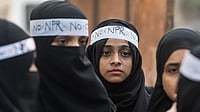Driven from his bed by troubled sleep
In which he dreamt of being lost
Upon a hill too high for him (a
modest hill whose sides grow steep)
He stood where several highways crossed
And saw the city, cold and dim,
Where only human hands sell cheap
—Nissim Ezekiel, A Morning Walk
A group of 10 people stand on the rain-dappled street on a Sunday morning with paper sheets clutched in their hands. The assembly point, in front of a very tall luxurious building, is significant for the group. The uber chic skyscrapers in the background tell the urban tale of development that Mumbai has been witnessing over the past decade. These skyscrapers—located on land that housed mills in a bygone era and fell silent following the 1982 textile strike called by unionist Datta Samant—are a stark contradiction to the low-walled, small tenements or chawls that were once an intrinsic part of the landscape here. In this transition from Bombay to Mumbai, the quaintness of the former is fighting a losing battle against the aggressive rapid growth of the latter.
On that Sunday morning, braving the slight drizzle, the group led by Saranya Subramanian, is trying to revisit the abandoned histories of mills and the chawls that sheltered the mill workers, through a poetry crawl. Walking through a pre-planned route, Saranya has chosen the poems carefully. They have to resonate with the theme for that day: From Malls to Mills—the Abandoned Histories Poetry Crawl. Standing in a semi-circle, the group reads a translated version of poet Narayan Surve’s Char Shabd (Four Words). The stillness of that Sunday morning reverberates the words from the poem—“The struggle for the daily bread is an everyday question; At times outside the gate, at times inside; I’m a worker, a flaming sword; Listen you intellectuals, I’m going to commit a crime”.
Even as this poem is being read by the group standing on the public pavement in front of the luxurious building, the security guards of the building try to shoo them away, saying that “it is not allowed”. As the reading continues, the security guards stand and watch from afar. It is as if the fire of Surve’s words has signalled them to back off.
Along the route taken from the suburban train station at Lower Parel to Phoenix Mills, the scene of the biggest development on mill land with outlets of international luxury brands vying for eyeballs with savvy Indian brands, the poems by Dilip Chitre, Amol Redij, Nissim Ezekiel, Surve, Malika Amar Shaikh, Namdeo Dhasal, Altaf Tyrewala, Melanie Silgardo, Adil Jussawalla and Keshav Meshram, were read, discussed and understood.

“I started the Bombay Poetry Crawl in 2020. It started out during the research that I was doing for Arun Kolhatkar’s Kala Ghoda poems,” says Saranya, the person behind the idea. “I was walking around Mumbai city for research. Since I had such an enriching time doing it, I wondered if heritage walks could be a way of preserving and propagating the great poetry by the 20th century poets of the then Bombay, in English, Marathi, Hindi and Urdu,” she says. She is employed as a senior content creator for The Ideas Studio.
The first walk took place in February 2020, right before the Covid-19 pandemic brought our lives to a standstill. “I had a small group of five, but I learnt then how to create a niche for myself with city walks through poetic lenses. During the pandemic lockdown months, the walks and talks were all virtual,” says Saranya. She resumed the walks on foot this year and is ecstatic at the response. All types of professionals joined these walks—artists, graphic designers, writers, journalists, architects, public relations executives, estate developers, entrepreneurs, etc.
One of the most popular walks has been the Abandoned Histories Crawl, where the respondents are introduced to the culture of the chawls that existed in Bombay. As Mumbai moved towards aggressive development with sky-walks, flyovers, metro trains, monorail and elevated road connectors taking centre-stage, the chawls started dying with people moving to the far-flung suburbs of Mumbai. In Bombay’s past, the chawls were looked at as unifiers of communities and an important area for the preservation of the traditions of people who lived there. It was an integral part of the mill economy.
According to references, in 1854, an enterprising Parsi businessman, Cowasji Nanabhoy, and an Englishman, Edwin Heycock, set about enhancing Mumbai’s capitalist ambitions. They set up the Bombay Spinning and Weaving Company in South Bombay’s Tardeo. In those days, it was the Koli fishermen who walked and sailed the seven isles casting their fishing nets. However, over a century after Nanabhoy started this new enterprise, it was the textile mills that cast a web of dreams over Bombay. Attracted by the idea of a steady income from the sale and export of spun cotton, villagers from the Konkan and the Marathwada belt arrived in Bombay in droves. This was the first large-scale migration into the city from the other parts of Maharashtra.
The later years saw migrants from across India making Bombay their home. In that century, these migrants worked in the mills that were dotting Bombay from Lalbaug-Parel in central Bombay to Girgaum in South Bombay. While the Lalbaug-Parel area came to be known as Girangaon and was inhabited by the blue collared mill workers, Girgaum became the residential area for the white collared managerial staff working in the mills.
The whole expanse saw the emergence of a new mill economy and throbbed with textile activities. By 1892, the mill workers accounted for 10 per cent of the population of Bombay. By the early 1900s, there were 200 textile mills in Bombay. This saw the advent of a host of new urban problems.
Poets like Meshram, a mill worker himself, wrote about housing for mill workers, sanitation facilities for the vast migrant population that kept coming into the city, schools for their children, and issues of medical aid which needed urgent attention. The unhygienic living conditions in Bombay resulted in the plague of 1896, which claimed the lives of 20,000 people. Soon, the city set up the Bombay City Improvement Trust in partnership with the mill owners and established chawls from the Lalbaug-Parel area to Girgaum. These essentially small, one or two room tenements with a long passage, common washrooms and bathrooms were built over several floors. A typical chawl is roughly spread over 100-200 sq ft with a common set of toilets on each floor. This low-cost housing could host a large workforce.
Since most of the mills were located in south and central Bombay, chawls were built in areas like Girgaum, Tardeo, Byculla and Parel. By 1911, nearly 70 per cent of the city’s population lived in the chawls. While the managerial class seeped into Girgaum, it was trade unionism, workers’ rights and the struggle for survival that dominated conversations in the chawls of Girangaon.
After the great mill workers’ strike, the mill economy collapsed. Today, the mill land is mushrooming with the swankiest malls in the country, a boom which has seen the loss of a city’s identity. “I bring to life this city verse by verse and step by step by taking people on poetry walks. We read poetry along the way while studying the changes that have come in after that poem was written. This allows me to be an archivist, researcher, urban planner, tour guide and a poet,” says Saranya. “In so many ways, poetry in Bombay was a strong and compelling force that no one could resist,” she says.
“For me, walking through these mills and seeing the chawls is a unique experience. Seeing them and walking through them are entirely different experiences,” says Anshu Maansath, a graphic designer who went on the Abandoned Histories Crawl. “Standing here at this intersection, where tall buildings dwarf these tiny houses, reading poetry and looking at such diversity, is a very different experience,” says Anshu.
To celebrate the 90th birthday of the late actor Meena Kumari (Mahjabeen Bano), the poetry crawl was through the lanes of Bandra, where she spent a major part of her life, reading poems written by her using the pseudonym Naaz. The poems brought out the various facets of the late actor’s life that shaped her as a poet. This evening walk, under the night lights of Mumbai, celebrated the late actor’s life beyond cinema.
According to Saranya, the Shorelines Crawl at Sassoon Docks was an engaging experience where a series of poems by Jussawalla were recited by the attendees. The crawl went through the street paintings and old buildings that have become the modern-day venue for art exhibitions. The overpowering smell of the sea and the beauty of the small, colourful fishing boats anchored to the shoreline heightened the poetry reading experience. At Sassoon Docks, lines from Jussawala’s Sea Breeze, Bombay—Partition’s people stitched Shrouds from a flag, gentlemen scissored Sind. An opened people, fraying across the cut country reknotted themselves on this island—mingled with the breeze blowing in from the churning waters of the sea.
For Diksha Ahire, a researcher at the Sarmaya Art Foundation, the experience of doing a poetry crawl is different from any other. “Walking, seeing the locality or experiencing the area where the poet spent his/her life enhances the living experience,” says Diksha.


























